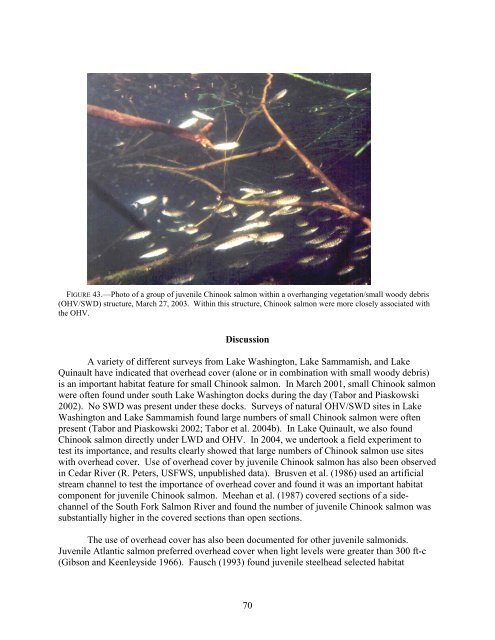Nearshore Habitat Use by Juvenile Chinook Salmon in Lentic ...
Nearshore Habitat Use by Juvenile Chinook Salmon in Lentic ...
Nearshore Habitat Use by Juvenile Chinook Salmon in Lentic ...
Create successful ePaper yourself
Turn your PDF publications into a flip-book with our unique Google optimized e-Paper software.
FIGURE 43.—Photo of a group of juvenile <strong>Ch<strong>in</strong>ook</strong> salmon with<strong>in</strong> a overhang<strong>in</strong>g vegetation/small woody debris<br />
(OHV/SWD) structure, March 27, 2003. With<strong>in</strong> this structure, <strong>Ch<strong>in</strong>ook</strong> salmon were more closely associated with<br />
the OHV.<br />
Discussion<br />
A variety of different surveys from Lake Wash<strong>in</strong>gton, Lake Sammamish, and Lake<br />
Qu<strong>in</strong>ault have <strong>in</strong>dicated that overhead cover (alone or <strong>in</strong> comb<strong>in</strong>ation with small woody debris)<br />
is an important habitat feature for small <strong>Ch<strong>in</strong>ook</strong> salmon. In March 2001, small <strong>Ch<strong>in</strong>ook</strong> salmon<br />
were often found under south Lake Wash<strong>in</strong>gton docks dur<strong>in</strong>g the day (Tabor and Piaskowski<br />
2002). No SWD was present under these docks. Surveys of natural OHV/SWD sites <strong>in</strong> Lake<br />
Wash<strong>in</strong>gton and Lake Sammamish found large numbers of small <strong>Ch<strong>in</strong>ook</strong> salmon were often<br />
present (Tabor and Piaskowski 2002; Tabor et al. 2004b). In Lake Qu<strong>in</strong>ault, we also found<br />
<strong>Ch<strong>in</strong>ook</strong> salmon directly under LWD and OHV. In 2004, we undertook a field experiment to<br />
test its importance, and results clearly showed that large numbers of <strong>Ch<strong>in</strong>ook</strong> salmon use sites<br />
with overhead cover. <strong>Use</strong> of overhead cover <strong>by</strong> juvenile <strong>Ch<strong>in</strong>ook</strong> salmon has also been observed<br />
<strong>in</strong> Cedar River (R. Peters, USFWS, unpublished data). Brusven et al. (1986) used an artificial<br />
stream channel to test the importance of overhead cover and found it was an important habitat<br />
component for juvenile <strong>Ch<strong>in</strong>ook</strong> salmon. Meehan et al. (1987) covered sections of a sidechannel<br />
of the South Fork <strong>Salmon</strong> River and found the number of juvenile <strong>Ch<strong>in</strong>ook</strong> salmon was<br />
substantially higher <strong>in</strong> the covered sections than open sections.<br />
The use of overhead cover has also been documented for other juvenile salmonids.<br />
<strong>Juvenile</strong> Atlantic salmon preferred overhead cover when light levels were greater than 300 ft-c<br />
(Gibson and Keenleyside 1966). Fausch (1993) found juvenile steelhead selected habitat<br />
70
















